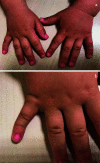CAMPTODACTYLY AND CLINODACTYLY - NEW UNDERSTANDING OF KNOWN DEFORMITIES
- PMID: 35282479
- PMCID: PMC8907952
- DOI: 10.20471/acc.2021.60.03.24
CAMPTODACTYLY AND CLINODACTYLY - NEW UNDERSTANDING OF KNOWN DEFORMITIES
Abstract
Camptodactyly and clinodactyly are most commonly considered just cosmetic defects, but they can pose a major diagnostic and therapeutic challenge, mainly because of their apparently similar clinical presentation. For years, experts have been arguing over definitions, descriptions, and therapeutic approaches to these deformities, with some favoring surgical approach, some advocating conservative treatment, while others are prone to use a combination of the aforementioned approaches. This article provides an overview of the current literature on two different entities, with emphasis on differences in clinical presentation and treatment modalities. This may improve the understanding and recognition of these deformities in children, and help the attending physician select the most appropriate therapy for the individual patient.
Keywords: Camptodactyly; Clinical presentation; Clinodactyly; Therapy.
Figures



Similar articles
-
Surgery and Conservative Management of Camptodactyly in Pediatric Patients: A Systematic Review.Hand (N Y). 2020 Nov;15(6):761-770. doi: 10.1177/1558944719834654. Epub 2019 Mar 22. Hand (N Y). 2020. PMID: 30897950 Free PMC article.
-
Camptodactyly: classification and results of nonoperative treatment.J Pediatr Orthop. 1994 Nov-Dec;14(6):814-9. J Pediatr Orthop. 1994. PMID: 7814601
-
Failure of differentiation: Part II (arthrogryposis, camptodactyly, clinodactyly, madelung deformity, trigger finger, and trigger thumb).Hand Clin. 2009 May;25(2):195-213. doi: 10.1016/j.hcl.2008.12.003. Hand Clin. 2009. PMID: 19380060 Review.
-
Autosomal dominant syndrome of camptodactyly, clinodactyly, syndactyly, and bifid toes.Am J Med Genet A. 2010 Sep;152A(9):2313-7. doi: 10.1002/ajmg.a.33552. Am J Med Genet A. 2010. PMID: 20683984
-
Distraction - A Minimally Invasive Technique for Treating Camptodactyly and Clinodactyly.Med J Armed Forces India. 2004 Jul;60(3):227-30. doi: 10.1016/S0377-1237(04)80051-0. Epub 2011 Jul 21. Med J Armed Forces India. 2004. PMID: 27407638 Free PMC article.
Cited by
-
Prenatal diagnosis of clinodactyly and its association with genetic syndromes: A case report.Case Rep Womens Health. 2024 Dec 6;44:e00674. doi: 10.1016/j.crwh.2024.e00674. eCollection 2024 Dec. Case Rep Womens Health. 2024. PMID: 39720354 Free PMC article.
-
Macrocephaly and Finger Changes: A Narrative Review.Int J Mol Sci. 2024 May 20;25(10):5567. doi: 10.3390/ijms25105567. Int J Mol Sci. 2024. PMID: 38791606 Free PMC article. Review.
-
A Complex Case of Clino-Syndactyly with Fourth Metacarpal Aplasia.Life (Basel). 2023 Sep 21;13(9):1943. doi: 10.3390/life13091943. Life (Basel). 2023. PMID: 37763346 Free PMC article.
References
Publication types
MeSH terms
LinkOut - more resources
Full Text Sources
